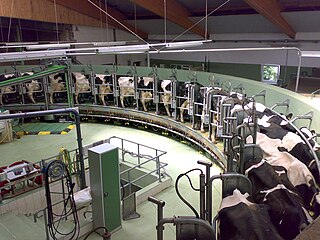 W
WDairy farming is a class of agriculture for long-term production of milk, which is processed for eventual sale of a dairy product.
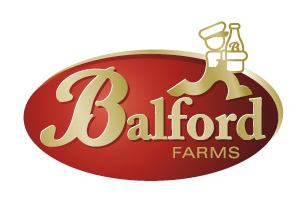 W
WBalford Farms is an American dairy company located in Burlington, New Jersey. It is the oldest privately-owned and operated independent distributor in the Lehigh Valley region.
 W
WCrowley Foods is an American dairy company formerly based in Binghamton, New York. It has been a subsidiary of HP Hood LLC since being purchased by the company in 2004, which is headquartered in Lynnfield, Massachusetts. Products provided by the company include milk, half and half, cream, cottage cheese, sour cream and yogurt. The original plant located on Conklin Avenue in Binghamton manufactured these dairy products until the acquisition by HP Hood, when certain Crowley Foods items began to be made at facilities elsewhere which were better equipped. Production at the plant ceased altogether in 2012, but the warehouse and distribution center continued to be used until 2014.
 W
WDairy cattle are cattle bred for the ability to produce large quantities of milk, from which dairy products are made. Dairy cattle generally are of the species Bos taurus.
 W
WDairy cattle evaluation is the process of placing a group of dairy cows in order from most to least desirable based on milk production and longevity, where each animal is compared against the "ideal" animal. Dairy cattle are evaluated based on physical traits that equate to high milk production, with slight variations between different breeds. Dairy cattle evaluation is primarily used by producers to select the best cows to keep in the herd.
 W
WShowing dairy cattle provides the dairy farmer a means of buying and selling their cows or heifers and selecting foundational cows for their dairy herd. Shows can be social events in addition to serving as important business opportunities, and ages of those who show and attend cover a broad range. Dairy shows are also an important tool in sparking the interest of young people to become involved in the dairy industry. The six breeds of dairy cows that are shown are Ayrshire cattle, Brown Swiss cattle, Milking Shorthorn, Guernsey cattle, Holstein cattle and Jersey cattle. In order to register for a show, payment and the registration for the cow or heifer must be submitted. The registration would include the breed, birthdate, dam and sire of the animal.
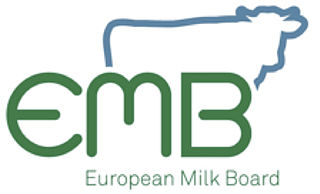 W
WThe European Milk Board (EMB) is the umbrella organization for 20 associations representing dairy farmers in 15 European countries. Established in 2006, the EMB's main goal are farm-gate prices that cover production costs in the dairy industry.
 W
WA goatherd or goatherder is a person who herds goats as a vocational activity. It is similar to a shepherd who herds sheep. Goatherds are most commonly found in regions where goat populations are significant; for instance, in Africa and South Asia. Goats are typically bred as dairy or meat animals, with some breeds being shorn for wool. The top six goat industry groups in the United States include: meat, dairy, fiber or hair, 4-H, industrial, and biotech.
 W
WA house cow is a cow kept to provide milk for a home kitchen. This differentiates them from dairy cows, which are farmed commercially. They can also provide manure, for use as a garden fertiliser, and their offspring can be a source of meat.
 W
WKemps is an American dairy company located in St. Paul, Minnesota. It has been a subsidiary of Dairy Farmers of America since being purchased in 2011 from HP Hood LLC. Dairy Farmers of America is based in Kansas City, Missouri, but Kemps continues to be headquartered in St. Paul. Products provided by the company include milk, cottage cheese, half and half, egg nog, cream, juices, sour cream, chip dips, ice cream, yogurt and novelties. Most of these products are sold at grocery stores throughout the midwestern United States, but some are available in other parts of the country as well. Kemps currently operates five manufacturing facilities in Minnesota and Wisconsin.
 W
WLacticaseibacillus casei is a species of genus Lacticaseibacillus. This particular species of Lacticaseibacillus is documented to have a wide pH and temperature range, and complements the growth of L. acidophilus, a producer of the enzyme amylase.
 W
WMaola Milk & Ice Cream Company, Inc. is a dairy company located in New Bern, North Carolina, United States. Products are distributed throughout North Carolina as well as parts of South Carolina and Virginia including milk, ice cream, juices, custard and novelties. The company has been a subsidiary of Maryland & Virginia Milk Producers Cooperative Association, Inc. since being acquired in 2003, based in Reston, Virginia.
 W
WBovine mastitis is the persistent, inflammatory reaction of the udder tissue due to physical trauma or microorganisms infections. Mastitis, a potentially fatal mammary gland infection, is the most common disease in dairy cattle in the United States and worldwide. It is also the most costly disease to the dairy industry. Milk from cows suffering from mastitis has an increased somatic cell count. Prevention and control of mastitis requires consistency in sanitizing the cow barn facilities, proper milking procedure and segregation of infected animals. Treatment of the disease is carried out by penicillin injection in combination with sulphar drug.
 W
WA milk churn is a tall, conical or cylindrical container for the transportation of milk. It is sometimes referred to as a milk can.
 W
WA milk churn stand was a standard-height platform on which milk churns would be placed for collection by cart or lorry. Some were simple and made of wood, but the majority were built from stone or concrete blocks. They were once a common roadside sight in Britain in areas which carried out dairy farming, but collection of milk churns from stands ceased in Britain in 1979. Many have survived, some being renovated to memorialise the practice, while others have been dismantled or left to decay.
 W
WMilk crates are square or rectangular interlocking boxes that are used to transport milk and other products from dairies to retail establishments.
 W
WMilk fever, postparturient hypocalcemia, or parturient paresis is a disease, primarily in dairy cattle but also seen in beef cattle and non-bovine domesticated animals, characterized by reduced blood calcium levels (hypocalcemia). It occurs following parturition, at onset of lactation, when demand for calcium for colostrum and milk production exceeds the body's ability to mobilize calcium. "Fever" is a misnomer, as body temperature during the disease is generally not elevated. Milk fever is more commonly seen in older animals and in certain breeds.
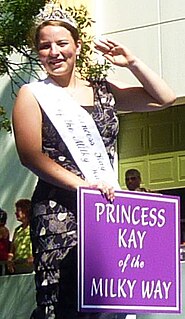 W
WMilk Queen is the title awarded to the winner of regularly-organized competitions by Dairy Associations in many countries.
 W
WAutomatic milking is the milking of dairy animals, especially of dairy cattle, without human labour. Automatic milking systems (AMS), also called voluntary milking systems (VMS), were developed in the late 20th century. They have been commercially available since the early 1990s. The core of such systems that allows complete automation of the milking process is a type of agricultural robot. Automated milking is therefore also called robotic milking. Common systems rely on the use of computers and special herd management software. Also it used to monitor the health status of cows.
 W
WA separator is a centrifugal device that separates milk into cream and skimmed milk. Separation was commonly performed on farms in the past. Most farmers milked a few cows, usually by hand, and separated milk. Some of the skimmed milk was consumed while the rest was used to feed calves and pigs. Enough cream was saved to make butter, and the excess was sold.
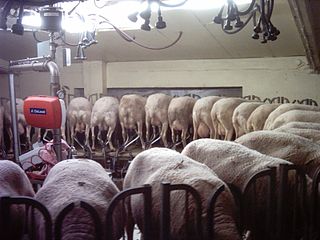 W
WSheep's milk is the milk of domestic sheep. It is commonly used to make cultured dairy products such as cheese. Some of the most popular sheep cheeses include feta (Greece), ricotta (Italy), and Roquefort (France).
 W
WA somatic cell count (SCC) is a cell count of somatic cells in a fluid specimen, usually milk. In dairying, the SCC is an indicator of the quality of milk—specifically, its low likeliness to contain harmful bacteria, and thus its high food safety. White blood cells (leukocytes) constitute the majority of somatic cells in question. The number of somatic cells increases in response to pathogenic bacteria like Staphylococcus aureus, a cause of mastitis. The SCC is quantified as cells per milliliter. General agreement rests on a reference range of less than 100,000 cells/mL for uninfected cows and greater than 250,000 for cows infected with significant pathogen levels. Several tests like the PortaSCC milk test and The California mastitis test provide a cow-side measure of somatic cell count. The somatic cell count in the milk also increases after calving when colostrum is produced.
 W
WTotal mixed ration (TMR) is a method of feeding dairy cattle. The purpose of feeding a TMR diet is that each cow can consume the required level of nutrients in each bite. A cow's ration should include good quality forages, a balance of grains and proteins, vitamins and minerals.
 W
WAn udder is an organ formed of two or four mammary glands on the females of dairy animals and ruminants such as cattle, goats, and sheep. An udder is equivalent to the breast in primates and elephantine pachyderms. The udder is a single mass hanging beneath the animal, consisting of pairs of mammary glands with protruding teats. In cattle, there are normally two pairs, in sheep, goats and deer, there is one pair, and in some animals, there are many pairs. In animals with udders, the mammary glands develop on the milk line near the groin, and mammary glands that develop on the chest are generally referred to as breasts.
 W
WThe Wanted 18 is a 2014 Palestinian-Canadian animated documentary about the efforts of Palestinians in Beit Sahour to start a small local dairy industry during the First Intifada, hiding a herd of 18 dairy cows from Israeli security forces when the dairy collective was deemed a threat to Israel's national security. The film combines documentary interviews with those involved in the events, archival footage, drawings, black-and-white stop-motion animation as well as re-enactments, and was co-directed by Canadian filmmaker Paul Cowan and Palestinian visual artist and director Amer Shomali. The film was the Palestinian entry for the Best Foreign Language Film at the 88th Academy Awards but was not nominated.
 W
WThe William and Estella Adair Farm, named the Broadacre Farm in 1922, is a 115-acre dairy farm in Carnation, Washington that illustrates the evolution of a typical dairy farming operation in the Snoqualmie Valley. Established in 1910, it was added to the National Register of Historic Places in 2002.